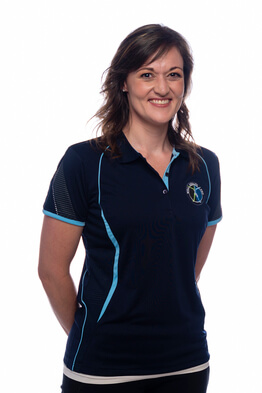Did you know that special receptors in your body constantly send information to your brain about where each body part is and what it’s doing? For instance, if you close your eyes and lift your hand up into the air, you will still know exactly where your hand is. This “sixth sense” is called proprioception or kinaesthesia. It’s easy to take this amazing sense for granted, but your life would be very slow and frustrating without it. Proprioception is how you can take a sip of coffee without looking at the cup, how you can walk around in a shop without always looking at your feet and kick a ball while you’re running.
What exactly is proprioception?
Proprioception is the awareness of the position and movement of the different parts of your body. In other words, your brain’s awareness of where you are and what you are doing at any given time.
But how does that happen? Special receptors in your skin, joints and muscles are activated when you move. The message is transmitted to your spinal cord and then to your brain. In your brain these messages are processed and a message is sent back to your body to get the appropriate response. These constant messages between your brain and body is called a feedforward and feedback.
Here’s a practical example: You are out for a walk, looking around at the scenery when you trip over a loose rock. This sudden movement triggers proprioceptors that send a message to your brain. After some processing, your brain realizes that your current position and movement will lead to you ending up on the ground. Now, your brain sends a message back to your body to respond to the situation. There will be different options to restore balance, so you might swing your arms, quickly move your weight to your other foot or do a bit of both. If these strategies don’t work, the constant information to your brain means that you will automatically try plan B. In this specific case, that might be reaching out with your hands to break your fall. All of this happens in a split second.
Why it’s important to restore proprioception after an injury
Any joint, ligament or muscle injury will affect your proprioception. Although the injury will heal, your proprioception won’t always recover. In the presence of pain your proprioceptive system is broken, impulses lag, response is delayed and reaction time slows significantly.
The main function of your proprioceptive system is to protect you. It should ensure that your adaptive mechanisms kick in automatically when something unexpected happens. For example if someone bumps into you or you slip on a wet floor. Proprioception also helps you to use the right amount of force at the right time. Lifting a pen requires a lot less force than lifting a heavy suitcase, and the special receptors in your body help you to adapt as needed. However, your proprioceptors can only protect you if your brain knows your limits. Without the right information, your brain can’t respond in time which leads to reinjury or further injuries. We see this happen quite often after ankle sprains. After the ankle and ligaments heal, proprioception is still affected for months or even years after the injury.
Why is it important to retrain proprioception after an injury?
- Restores or improves balance
- Normal reaction in a crisis to adapt
- Improves motor control
- Reduces risk of reinjury
- Prevent falls
- Facilitates healing
- Pain management
- Participate unrestricted in sports
- Break down fear avoidance (fear of movement)
“You have to know your limits before you can get past them”
What is fear avoidance?
Fear avoidance is a complication that develops after an injury. Think of a time when you had an injury. One of your body’s protective mechanisms will be to avoid putting extra pressure on the injured area. If you have a thorn in your foot, you’ll walk with a limp. In the case of a paper cut, you will avoid using that finger in your daily activities.
These are only simple examples of fear avoidance, in reality it’s actually quite subtle. Someone with shoulder pain will start to avoid lifting their arm by using the other hand. After a while it becomes their default and they don’t even notice it anymore. They start to avoid and neglect the area to avoid pain. Proprioceptive retraining is an important part of treating the fear avoidance that always accompany injuries. Otherwise, you will keep on neglecting the area leading to a vicious cycle of muscle weakness, pain and compensations that puts extra strain on the rest of your body.
Principles we use to retrain proprioception
Proprioception is very closely linked to your ability to adapt to changes in the environment. It allows you to move with confidence, knowing that you can cope with whatever comes your way. When pain of injuries limit your proprioception, you will also lose some of the confidence moving that body part. Unfortunately, your brain learns a bad habit very quickly, so proprioception will only improve up to the limit that you push yourself. If your arm was in a sling for 6 weeks it would naturally adapt to that position. You’ll be good at keeping your arm in a comfortable position close to your body, but that doesn’t leave much room for getting cups out of the cupboard on the top shelf not even stretch out if you trip over a rock.
Retraining proprioception is crucial to get rid of these bad habits and get your confidence back. Initially, we will start retraining in comfortable, stable positions. Over time, your rehabilitation program will start to include more challenging exercises and unstable positions to prepare you for sudden changes. This ensures that you can control movement in different positions, different directions and speeds where necessary. Even more importantly, you should be able to adapt to these changes effortlessly and without thinking. Like jumping onto a wabble board.
Different types of application
All the manual (in other words “hands-on”) techniques used by your physiotherapist will fall have an effect on your proprioceptive system. As we work on specific joints, muscles and movements, the special receptors in these structures will constantly send information to your brain. This information can help your brain to reorganise and retrain movements and motor control of muscles. This is conditioning the nerve pathways to re-act faster and regulate force with precision.
Techniques we use with the specific aim of improving proprioception include:
Static balance exercises – you need to maintain a position of a part of your body. For example, standing on one leg.
Dynamic balance exercises – similar to static balance, but now we add movement of another body part. For example, throwing a ball while standing on one leg.
Rhythmical stabilisation – in this technique you need to keep a part of your body in a certain position, while your physiotherapist applies forces in different directions. For example, you hold your arm out at shoulder height and the practitioner tries to push your arm up, down, left or right.
Joint mobilisation – an external force is applied by your physiotherapist on a peripheral joint or your spine. These are usually small, controlled movements and can also be applied in different directions. How we apply force will depend on your symptoms and the stage of healing of your injury.
Self-test
- Find a flat surface to stand on and remove your shoes.
- Lift one foot off the ground and find your balance just standing on one leg. If you can’t keep your balance standing on one leg, don’t move on to the next part.
- Now the tricky part – close your eyes and still maintain your balance.
If you lose your balance when you close your eyes, or is you couldn’t even get to the tricky part, it means that your proprioception isn’t what it should be. You should be able to balance closed eyes on one leg for 120 seconds.
What can I expect to feel during proprioceptive retraining?
We use various techniques for proprioceptive input during a session, but with specific focused exercises you will mostly feel that it takes a lot of concentration. Sit for a moment and try to move your ears without using your hands. That’s the kind of concentration and effort you might feel during proprioceptive exercises. For someone who can move their ears, it happens without thinking. They probably can’t even tell you how they’re doing it or how they learnt the trick. (Don’t worry, most people can’t move their ears, so we won’t expect you to learn that particular skill.)
These exercises may seem difficult at first. As your brain reconnects and finds the pathway, the same exercises will become effortless and you won’t even remember that you ever had trouble mastering it.
Isn’t there a faster way to “fix” proprioception?
Unfortunately, there are no short cuts with rehabilitation programs and proprioception is no exception. On the bright side, it’s easier to relearn a skill than to learn it from scratch. And it’s even better to learn a skill correctly from the beginning than to retrain an incorrect pattern or habit.
What we see at the practice, is that a person already had poor proprioception (or balance) before their injury happened. That doesn’t mean that decreased proprioception was the cause of the injury, but it’s often a contributing factor. In these cases, the injured tissue needs time to heal while we also address proprioception during treatment. Tissue healing takes at least 4-6 weeks, and this timeline can be months to a year in the case of ligament- and tendon injuries. The good news is that it’s never too late to improve your proprioception after an injury.
Do I need more than one session – can’t I just keep doing the exercises at home?
When you are in pain after an injury, your range of movement and how well you move will be affected. Your physiotherapist can give you the right exercises that you need during your specific phase of healing. As you heal and your pain improves, your range of motion will also start returning to normal. For instance with an achilles tendon rupture you need to use crutches in the early phases of healing. Therefore, the proprioceptive input you need is in a non-weightbearing position. In the next stage of healing you start to put more weight on the injured side and your exercise program must be adapted according to what your healing tendon can handle. You can’t retrain what you don’t have, so your rehabilitation needs to match where you are in your healing journey. If you practice standing on one leg you’ll get good at standing on one leg, but what about jumping, running or changing direction?
Your physiotherapist will discuss a treatment plan with you and give you an idea of how long it will take for your condition to improve. The treatment plan will also include often treatment is needed and what milestones you need to reach to progress to the next phase. Some injuries need 2-3 sessions over a period of 2 weeks, while other cases will need 6-8 sessions in a 12-week protocol.
What can I do in between sessions to make proprioceptive training more effective?
- The best way to speed up the process is to tune in to what you feel in your body during the day. What is your shoulder blade doing when you brush your hair? How does it feel in your knee when you climb stairs?
- Incorporate your exercises into your day as much as you can. Stand on one leg while you’re waiting for the kettle to boil or do your neck exercises while you’re checking messages on your phone.
- You can also find external cues to remind you to do your exercises. For example, every time you see something blue or if your hear a dog barking.
- Do your exercises for short periods many times a day, rather than a long session once a day. You’ll know that it’s time to stop if your mind starts to wander.
Cost of proprioceptive training
There is no specific medical aid rate for proprioceptive training, partly because the majority of physiotherapy techniques and modalities provide proprioceptive input. This means that every treatment will have an effect on your proprioceptive system. Therefore, you will never pay for proprioceptive exercises on its own but rather the whole treatment package.
Not only can poor proprioception increase your risk of having the same injury again, it can also predispose you to other injuries. So the question shouldn’t be if you can afford to seek help for impaired proprioception, but rather can you afford not to?
Medical Aid Code – 501 or 305
Proprioceptive retraining will form part of the medical aid codes 501 or 305, where a 501 code is used for rehabilitation and 305 for re-education of movement.
Does it make a difference to go to an experienced physiotherapist for proprioceptive retraining?
An experienced physiotherapist’s practiced eye and knowledge of human movement makes all the difference. You could find hundreds of exercises to improve proprioception on the Internet, but Google can’t guide you on the finer points of rehabilitation.
The first challenge is to identify where on the spectrum you are, and start there. If an exercise is too easy, your body won’t adapt to improve proprioception. On the other hand, if an exercise is too difficult, you will get the wrong adaptation and learn to compensate using the wrong movement patterns.
Our physiotherapists have years of clinical experience with rehabilitation programs. We can prescribe the right exercises at the right time for your specific problem.





